Great for close matches with trees.
Introducing The Theory of Family Relativity™ — a Genealogy Game-Changer
- By Esther
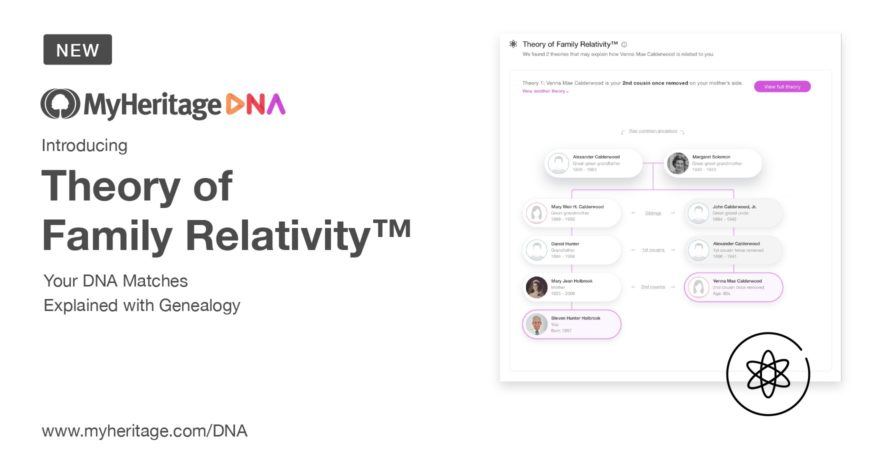

We’re excited to introduce a new feature, which is a total game-changer in genetic genealogy — the Theory of Family Relativity™. This unprecedented feature helps you make the most of your DNA Matches by incorporating genealogical information from all our collections of nearly 10 billion historical records and family tree profiles, to offer theories on how you and your DNA Matches might be related. If you’ve taken a MyHeritage DNA test or uploaded your DNA results to MyHeritage, this revolutionary technology may offer astounding new information on your family connections.
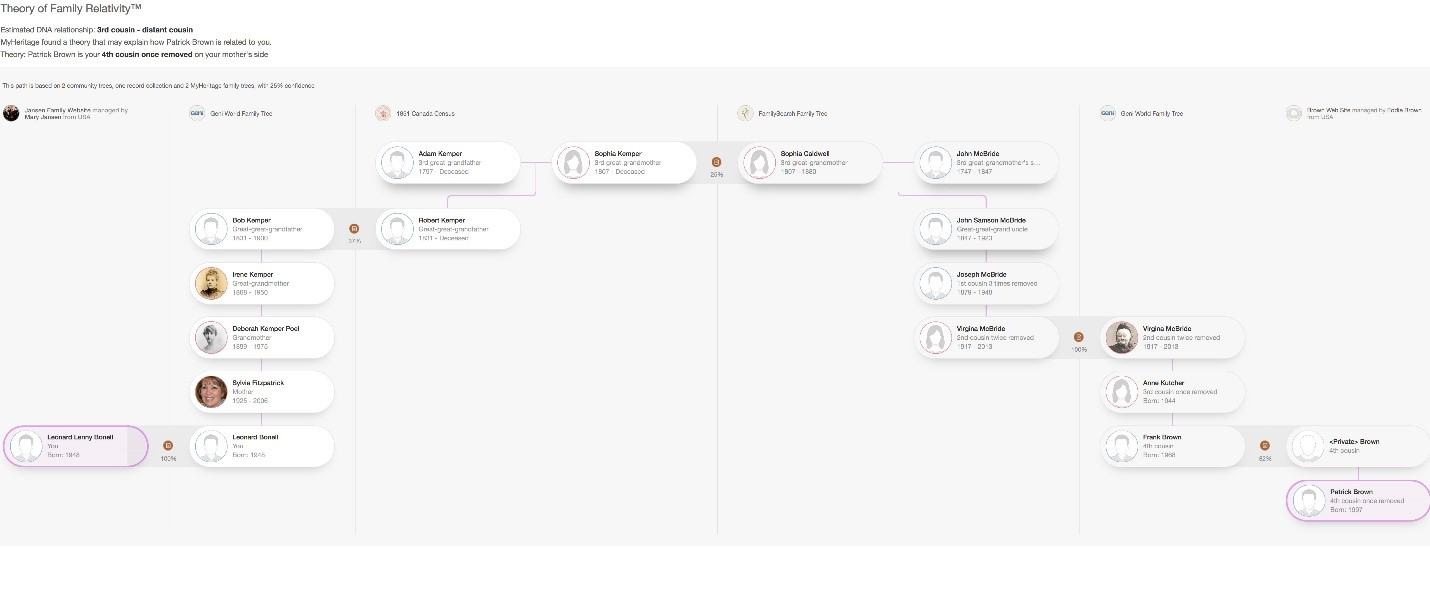
Powerful Theory of Family Relativity™ example suggesting a relationship path for a DNA Match, traversing trees from MyHeritage, Geni and FamilySearch, and a Canadian Census record! (Click to zoom)
Until now, family history enthusiasts used two distinct domains for making discoveries: the paper-trail world of historical records and family trees, and the biological world of DNA connections. When you received DNA Matches, it was often not clear how exactly the match is related to you and who your common ancestor may be. The “holy grail” of genetic genealogy is receiving DNA Matches where you know the full relationship path between you and each DNA Match and can add new information to your tree based on that.
We have introduced multiple features that enhance DNA Matches with the goal of achieving this, such as Shared Smart Matches™, Shared Ancestral Surnames, or Shared Ancestral Places. Power tools such as the Chromosome Browser also offer additional clues. While these features are extremely useful, and can sometimes help you identify the relationship path to your DNA Matches and the common ancestors, most people still hit brick walls with DNA Matches where they cannot figure out the exact connection and how the DNA Match fits in their family tree. Moreover, up until now, the information we presented was based solely on your family tree and your DNA Match’s family tree. This meant that you only had whatever information you and they had entered to go on, and most often, the common ancestors do not appear in either your or your match’s family tree. With the release of the Theory of Family Relativity™, we have bridged the gap between DNA Matches and historical records and integrated both worlds seamlessly. The “holy grail” has been found!
Through this new feature, we provide you with leads explaining the relationship between your matches based on our entire collection of family trees and historical records, removing the guesswork, and saving you hours of research time. You can then examine the theories and the information associated with them and verify their correctness.
By collecting all available sources of information on MyHeritage, and harnessing the complete power of them collectively, we can unlock mysteries that were never solved before.
How does it work?
The Theory of Family Relativity™ is based on a big data graph that connects billions of data points drawn from thousands of databases on MyHeritage, in real time. We call it internally the “Big Tree”. Every node on this graph represents a person, and every edge depicts a blood relationship between two individuals that is described in a family tree or a historical record; or a match between two tree profiles that are likely to be the same person; or two records that are likely to be about the same person.
MyHeritage’s industry-leading matching technologies establish these connections between people and records. MyHeritage engineers and algorithm experts have developed a unique approach that allows the “Big Tree” to compute all paths between millions of blood relatives instantly. The Theory of Family Relativity™ draws upon this resource to construct the most plausible theories explaining how pairs of people linked by a DNA Match on MyHeritage are related, using family trees and historical records. The “Big Tree” is not static, so it never grows stale as users add or delete new information, or reject certain matches that they consider incorrect. Instead, we compute it quickly whenever we want, generating a fresh view of the world that gets larger and more accurate all the time. The “Big Tree” is unique in that it encompasses all family trees on MyHeritage and the huge collaborative trees of Geni and FamilySearch that are replicated to MyHeritage.
The number of theories you may get depends on several factors, such as the size and level of detail in your family tree (the more the better). This number will increase over time as more users test their DNA on MyHeritage or upload their DNA result, and as we continue to add more historical records and as family trees continue to grow.
It is important to keep in mind that this revolutionary feature produces theories that are just that — theories. They are based on a lot of information provided by other users who may introduce mistakes in family trees as well as matches between tree profiles and records that may be inaccurate. We strongly suggest that you review the theories in depth and judge for yourself whether each one is accurate and decide how to best proceed further with your genealogical research. Verifying everything is a best practice that every good genealogist should do regarding all clues and evidence. Remember that theories can be very helpful, but they are not always correct.
Using the Theory of Family Relativity
Theories will usually be found for some of your DNA Matches.
Visit your DNA Matches to see them. During the introductory period of this feature, a banner, shown below, will be displayed at the top of your DNA Match list telling you if you have theories. Click the button on this banner to conveniently view all your DNA Matches that have theories.
Whenever a DNA Match has a theory, this is also indicated in the DNA Match card, as shown below.
When the estimated relationship (according to the shared DNA) is a wide range, with no clear indication of the true relationship, the theory will assist in narrowing down the relationship. You can compare the relationship suggested by the theory to the relationship suggested by the DNA to see if they are compatible.
Click “View theory” on the card will display the full theory, including the complete relationship path. Alternatively, you can start with a summarized view of the theory which is presented in the Review DNA Match page.
When more than one theory is available, this means that we have identified several theories with different relationships between you and the DNA Match. This can happen when people in the family have married within the family in earlier generations. In these situations, you can choose which theory to view by choosing from the drop-down menu.
In summarized theory view, move the mouse over any individual to see additional information.
Click “View full theory” to see a more detailed view that shows which family trees and historical records were used to establish the theory.
Viewing a full theory is a unique capability where MyHeritage’s new technology really shines. Its importance is in that it allows you to see how MyHeritage established the relationship path and which sources of information were used along the way.
The top of the Full Theory page shows the estimated relationship (by the DNA) and the relationship suggested by the Theory of Family Relativity™. If more than one theory was found, as mentioned above, you can switch between them.
Theories always begin in your tree and end in the family tree of your DNA Match. The traversal of the path may include other family trees on MyHeritage, Geni, FamilySearch or historical records.
Every time you see a horizontal “hop”, this means the theory is using a match to continue from one source to the next. Each Smart Match or Record Match is graded with a confidence level in percent, based on the quality of the match. The higher the score, the better the match is. Smart Matches and Record Matches that were rejected are never used in theories and we also require a very high minimum confidence for every match along the way, to ensure that theories you see are in very high quality. The lowest confidence among the matches, is considered the confidence score for the entire theory (and is displayed at the top of the page).
Within each theory, there are often multiple paths, showing different ways that we arrive at the same theory and providing more evidence to support it. All paths still culminate in the same summarized theory, but differ in the sources used along the way. For example, one path may start in your family tree and end immediately in the DNA Match’s family tree: such a short path, if exists, will always be offered first. There may be other paths among the same relatives that follow other trees or other historical records. Clicking any path number to view it.
The green icon represents a Smart Match™ between two trees on MyHeritage.
The brown icon represents a Record Match. These are matches with historical records.
Side comment: there is something a bit confusing here because matches with trees on Geni and FamilySearch are currently considered as Record Matches because they are not trees on MyHeritage (although they are family trees and not records). In the future, we will probably reclassify such matches as Smart Matches and we might even rename “Smart Matches” to “Tree Matches” one day.
Click on a match icon (green or brown) to see a convenient side-by-side comparison of the information that exists for that individual in the two sources. Using this information you can determine for yourself whether the match is accurate.
In the example above, the Smart Match looks accurate so it is safe to rely on it.
There is more to a theory than meets the eye. Moving the mouse over any item in a theory opens a tooltip with more information about it. For example, you can move the mouse over the name of a tree owner in order to get access to buttons for contacting that person or viewing the tree. Moving the mouse over a collection name or a historical record opens a tooltip with buttons that allow you to search it, and so on.
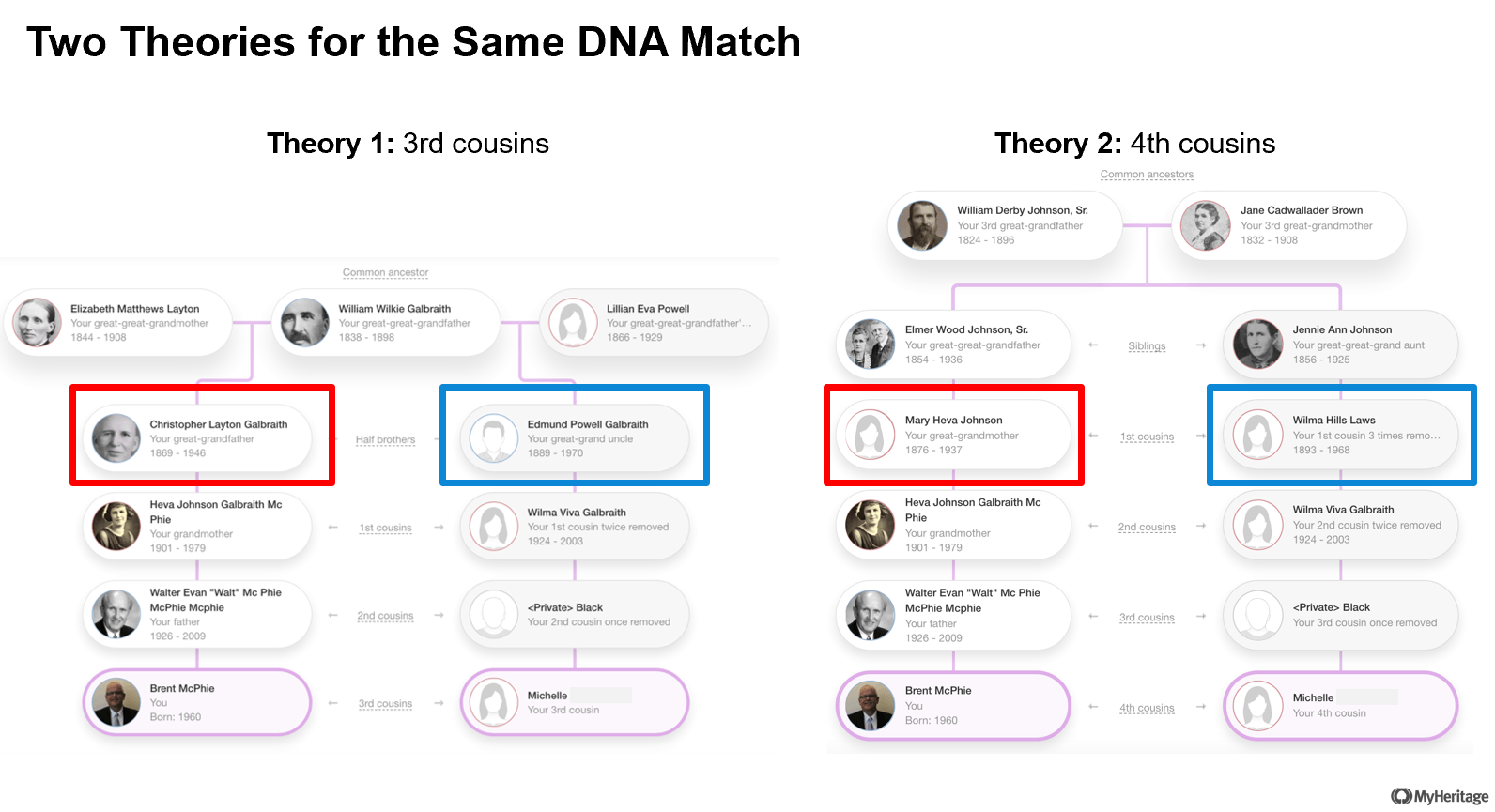
Example of two theories for the same DNA Match, due to two half-brothers marrying two first cousins (Click to zoom)
Filters
There is an easy way to see all the theories you have.
You can now filter your DNA Matches to see only those matches that have a Theory of Family Relativity™. Do this by clicking the “Filter” toolbar, select “Tree details” and then click on the “Has Theory of Family Relativity™” option. This is available in addition to the previous filtering options that show you which of your matches share places, ancestral surnames and other Smart Matches™ with you.
What to do if a theory seems correct
If you have a theory that looks good to you, congratulations! It tells you how you are related to a DNA Match, and you can view the full theory and add the people and information that are currently not in your tree, to your tree. In this first release, we did not provide a way to do that automatically, i.e. to add a branch to your tree in one click, but we may allow that in the future if there is enough demand for it. For now, add new information manually to your tree, like a good ol’ genealogist.
What to do if a theory is wrong
Currently, it is not possible to confirm or reject a theory. Perhaps we’ll add that functionality later on.
If you consider a theory as incorrect because of a wrong Smart Match in your tree, you can easily reject that Smart Match in the Smart Matches section of the website (accessible from the menu at Discoveries>Matches by People). This will cause the bad theory to disappear.
If you spot a wrong theory because of a mistake that another user made in their tree, please consider being a good genealogy citizen by contacting the tree owner where you spotted this mistake and letting them know what you think is wrong. Once they fix it, it will repair the theory or eliminate it altogether.
If a theory is incorrect due to a match and that match is not in your tree, you can let the tree owner know about it so they will reject that match. Or you can simply ignore any theory that you consider as incorrect.
Privacy
There are almost no privacy concerns with this new feature, because when traversing a theory, MyHeritage will automatically privatize the details of living people outside of your tree. Most theories do not include any living people (besides you and the DNA Match whose details are visible anyway), because theories only traverse through ancestors to find a blood relationship, they never go down to younger generations, so they very quickly reach previous decades and centuries in the realm of deceased ancestors.
Users who do not wish to see any theories or to have their family tree participate in theories suggested to other users can use the privacy settings to opt out of this (by disabling Smart Matches for their tree and its inclusion in SuperSearch and making sure that their site is not visible to guests). This is possible, but not recommended, as it will prevent them from receiving Smart Matches and other benefits.
Summary of benefits
T he “holy grail” of genetic genealogy is to understand exactly how you are related to your DNA Matches. The Theory of Family Relativity™ gives you just that, on a silver platter. However, speaking of silver, it’s not a silver bullet, because you will not get theories for all your DNA Matches, and some theories may be incorrect.
he “holy grail” of genetic genealogy is to understand exactly how you are related to your DNA Matches. The Theory of Family Relativity™ gives you just that, on a silver platter. However, speaking of silver, it’s not a silver bullet, because you will not get theories for all your DNA Matches, and some theories may be incorrect.
Here are the main benefits you’ll get from this new feature:
* You will make new discoveries. Theories will explain some of your DNA Matches using genealogy (trees and records), allowing you to solve brick walls and (manually) add entire new branches to your family tree.
* You will discover new ancestors, because theories go beyond the boundary of your tree, and include people from other trees and records, including new ancestors that are not in your tree currently.
* You will gain confidence. Theories will give you an indication, based on DNA, of which Smart Matches you can trust, allowing you to add people and information to your tree based on tree matches that you were previously skeptical about (or unaware of).
* You will save time. By exploring your theories you can save hundreds of hours of research that would have been required for you to reach the same conclusions yourself using the 10 billion records and tree profiles on MyHeritage.
* You will get more theories every month as the MyHeritage DNA database, family tree database and historical records database grow by leaps and bounds every day.
Cost
Theory of Family Relativity™ is a premium feature that requires a site subscription on MyHeritage (Premium or PremiumPlus or Complete). Users who upload their raw DNA data from another testing service to MyHeritage and do not wish to purchase a subscription can pay a one-time fee of $29 per kit to unlock all advanced DNA features offered by MyHeritage, including Theory of Family Relativity™. Learn more about our subscription plans here. Users without a subscription will still see all theories that we found for them, but when they click to see the full theory details, some of the information will be hidden.
Credits
The Theory of Family Relativity™ was a team effort to which many people at MyHeritage contributed, over a period of nearly 2 years. The overall concept for this feature as well as its name were invented by MyHeritage’s founder and CEO, Gilad Japhet. The realization of its vision was made possible through genius technological breakthroughs made by our CTO, Sagi Bashari. The user interface concepts were invented and polished by our senior VP of Product Management, Uri Gonen, and further enhanced by our DNA Product Manager, Ran Snir. The functionality was programmed by the excellent engineering team at MyHeritage which includes many skilled algorithm and user interface developers. The beautiful design was provided by our Design and UX team and quality assurance was provided by our QA team. Many other groups at MyHeritage took part in the realization of this significant genealogical and technological breakthrough.
Competition?
We’ve just learned that one of our major competitors has released a feature that resembles our Theory of Family Relativity™. That’s good as it shows that great minds think alike! It’s also a blessing for the entire genetic genealogy community. However, there is a big difference (note Einstein’s reaction above 😊). On MyHeritage, you can view any theory, see its full path and verify its correctness. You can see and contact all the tree owners along the way of the theory traversal, and examine all the matches and see if they make sense. It is much easier that way to spot incorrect theories, and to add much more to your tree than only just the direct line of people leading to the common ancestor and back. On the competing solution, only a summarized view of each theory is provided, and users are asked to treat it as gospel and “take it or leave it”, without being able to verify it or see the full path or the matches, and no additional information is provided on the source of the information, the family trees used along the way or additional relatives that can be found in them. Thus the MyHeritage feature is clearly superior.
Conclusion
The Theory of Family Relativity™ is a game-changer in genetic genealogy, finally bringing together the worlds of genealogy and DNA. It harnesses the full power of all assets on MyHeritage – the 10 billion historical records and tree profiles, the 2.5 million strong DNA database, the Smart Matches, the Record Matches, and the Record Detective Matches. It allows the genealogy domain to explain DNA Matches, and the DNA domain to validate genealogical matches.
MyHeritage promises to always strive to develop innovative technologies to make family history more accessible and to help break through genealogical brick walls. We are proud to yet again make good on this promise today.
We hope that the Theory of Family Relativity™ will help you on your family history journey and that it will open up exciting avenues of research for many of our users.
This is only the first of additional breakthrough features that we intend to provide using the new “Big Tree” infrastructure. Stay tuned for exciting new features in the future!

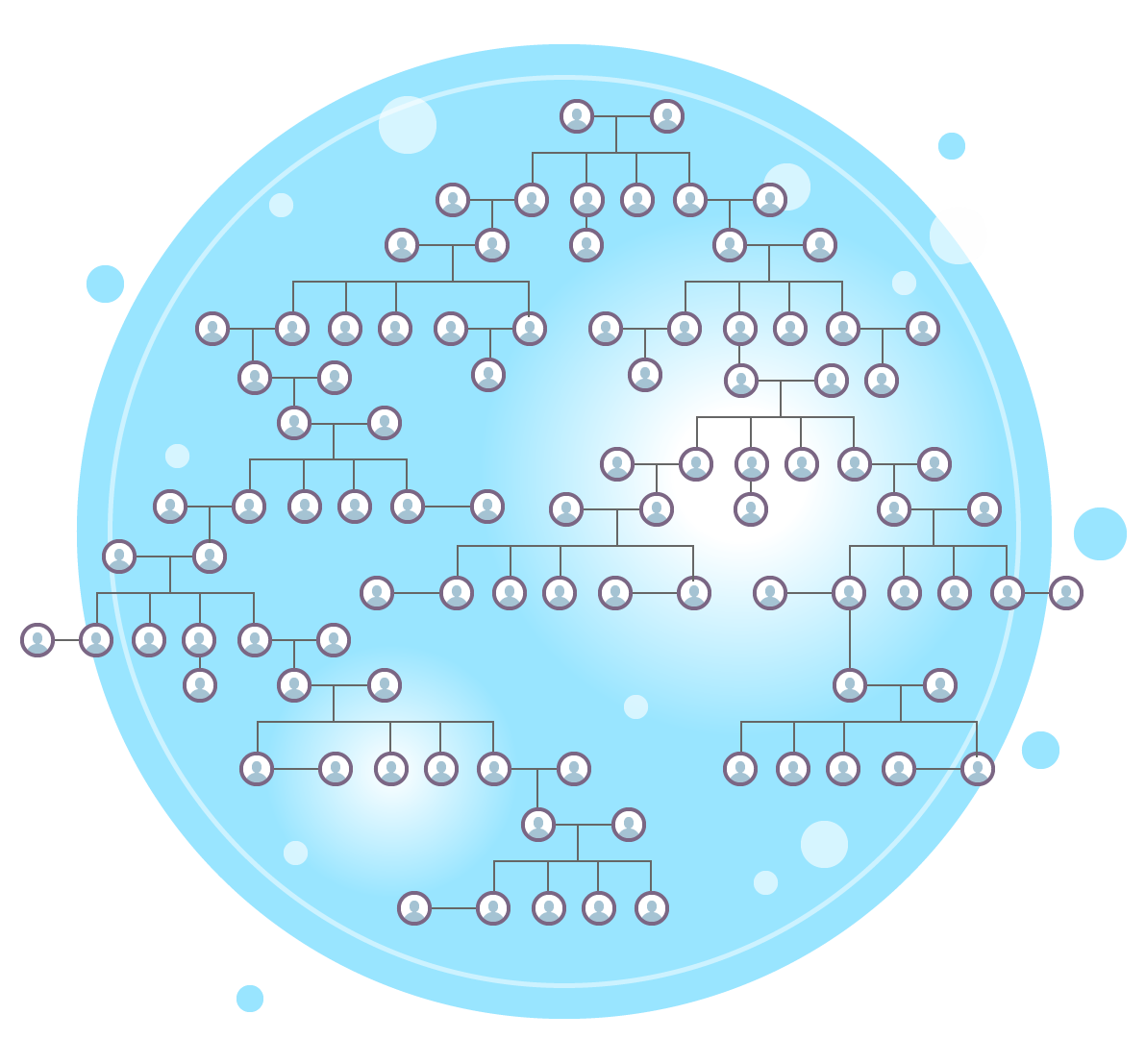


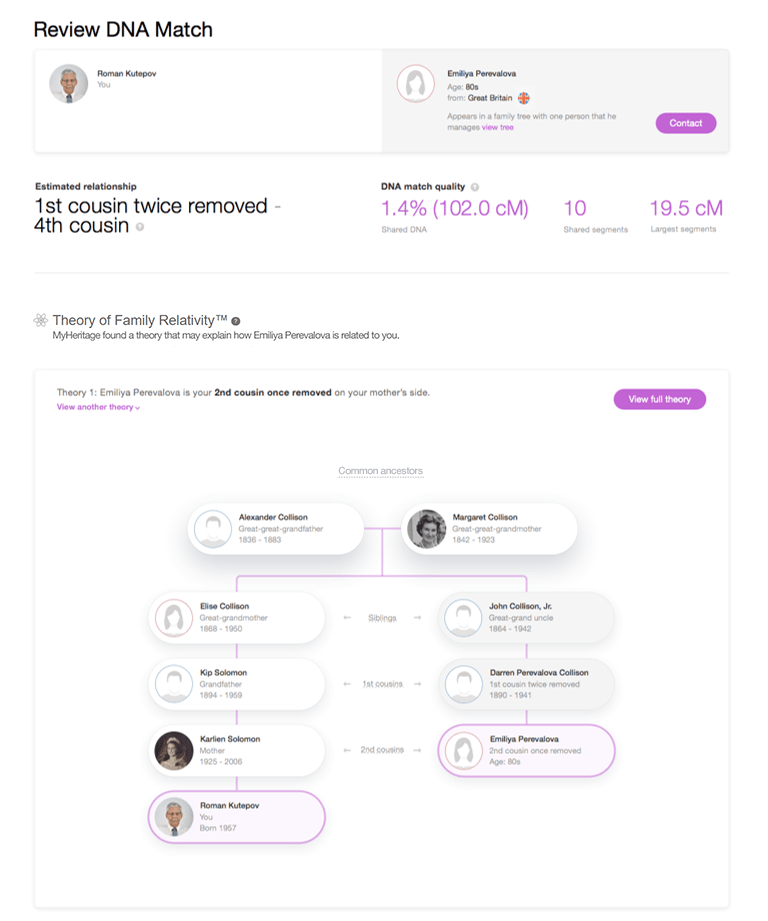
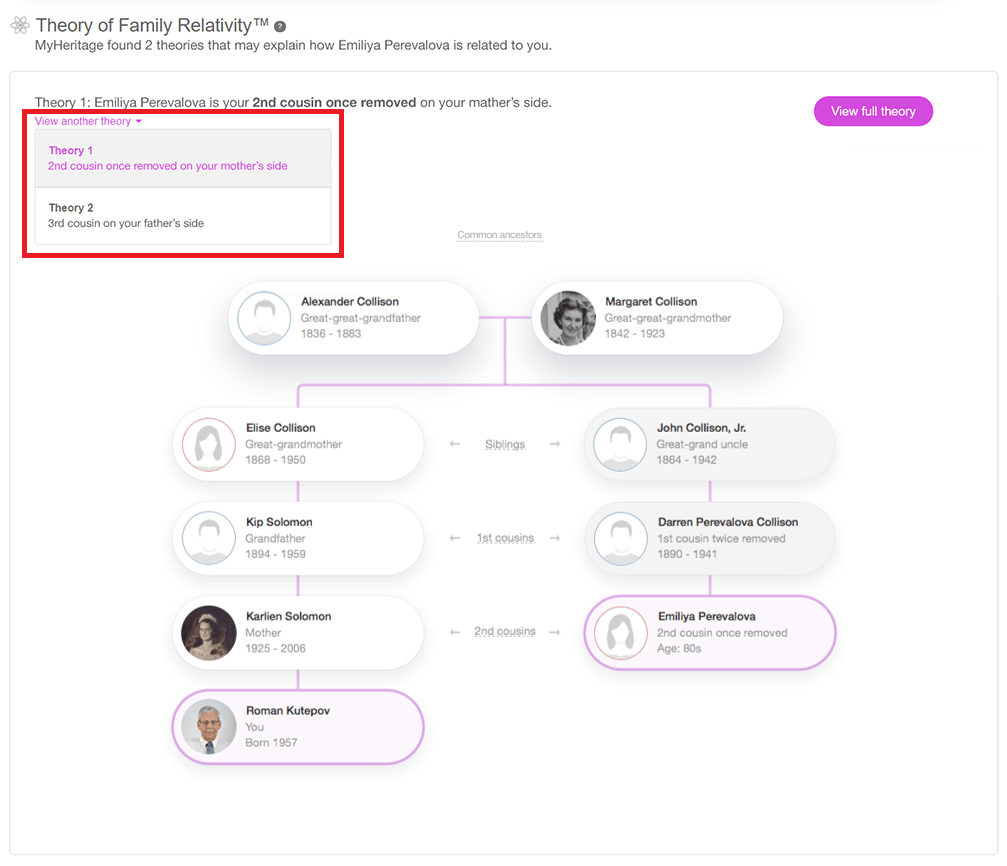
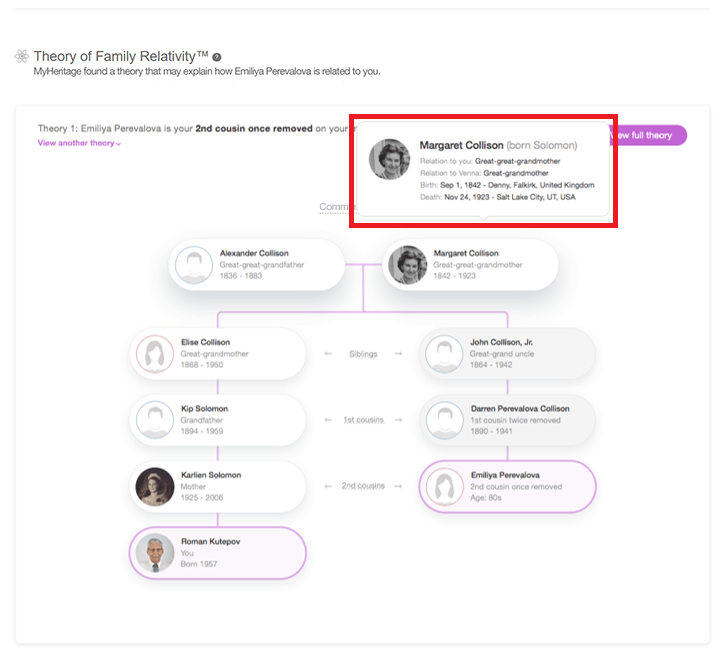
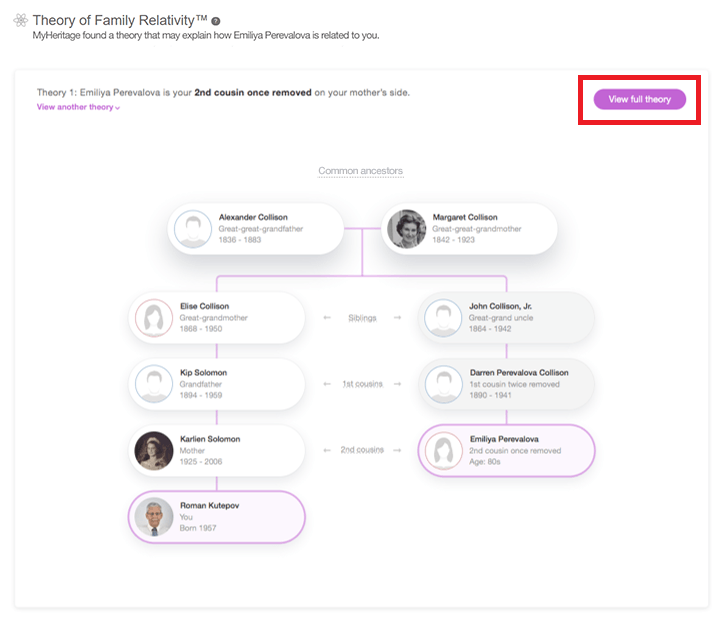
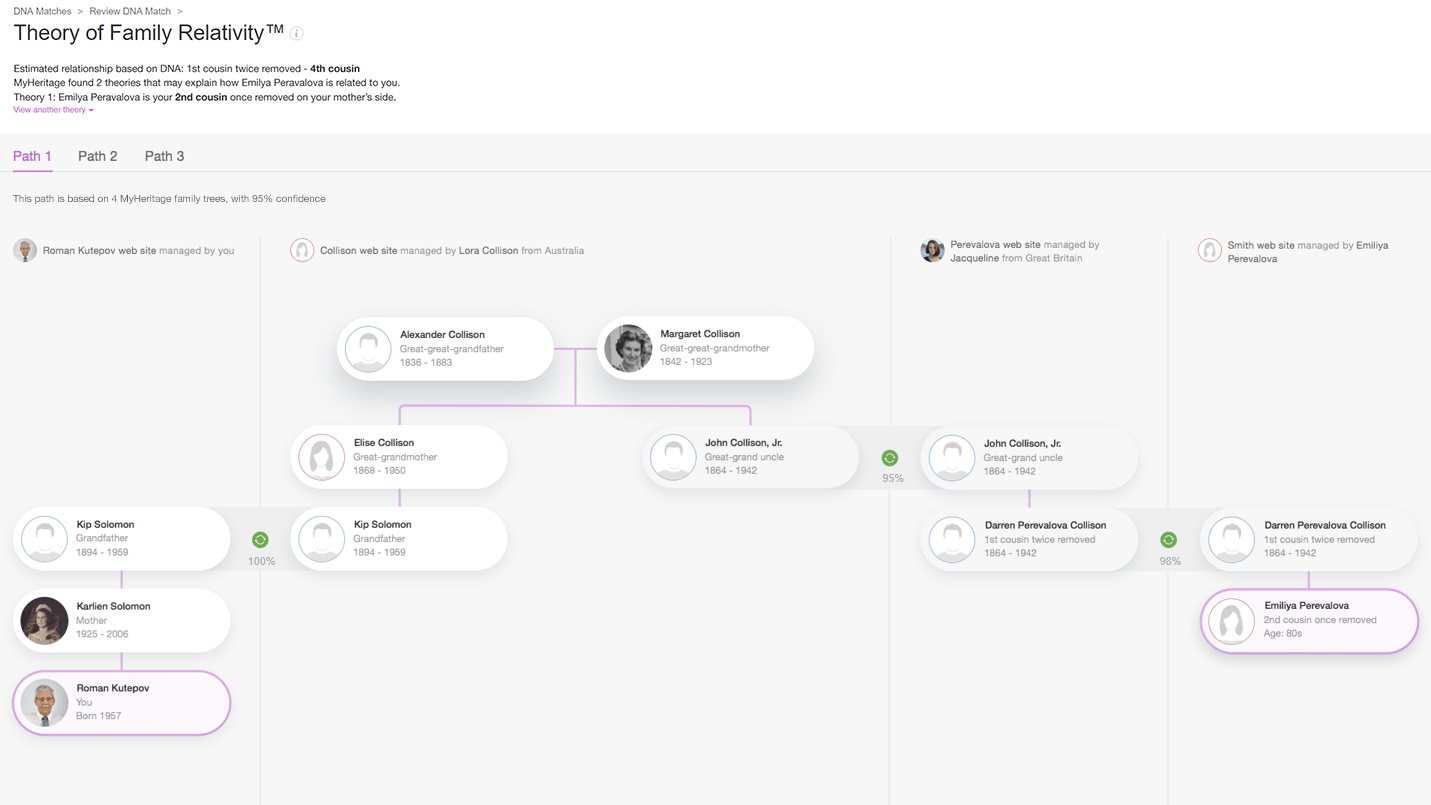
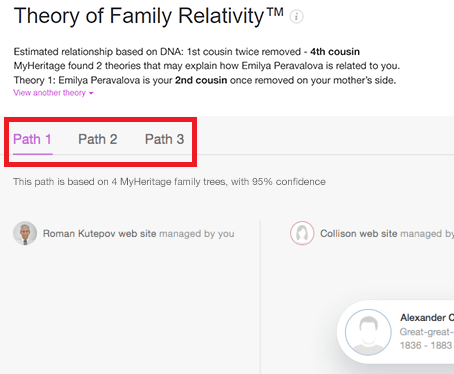




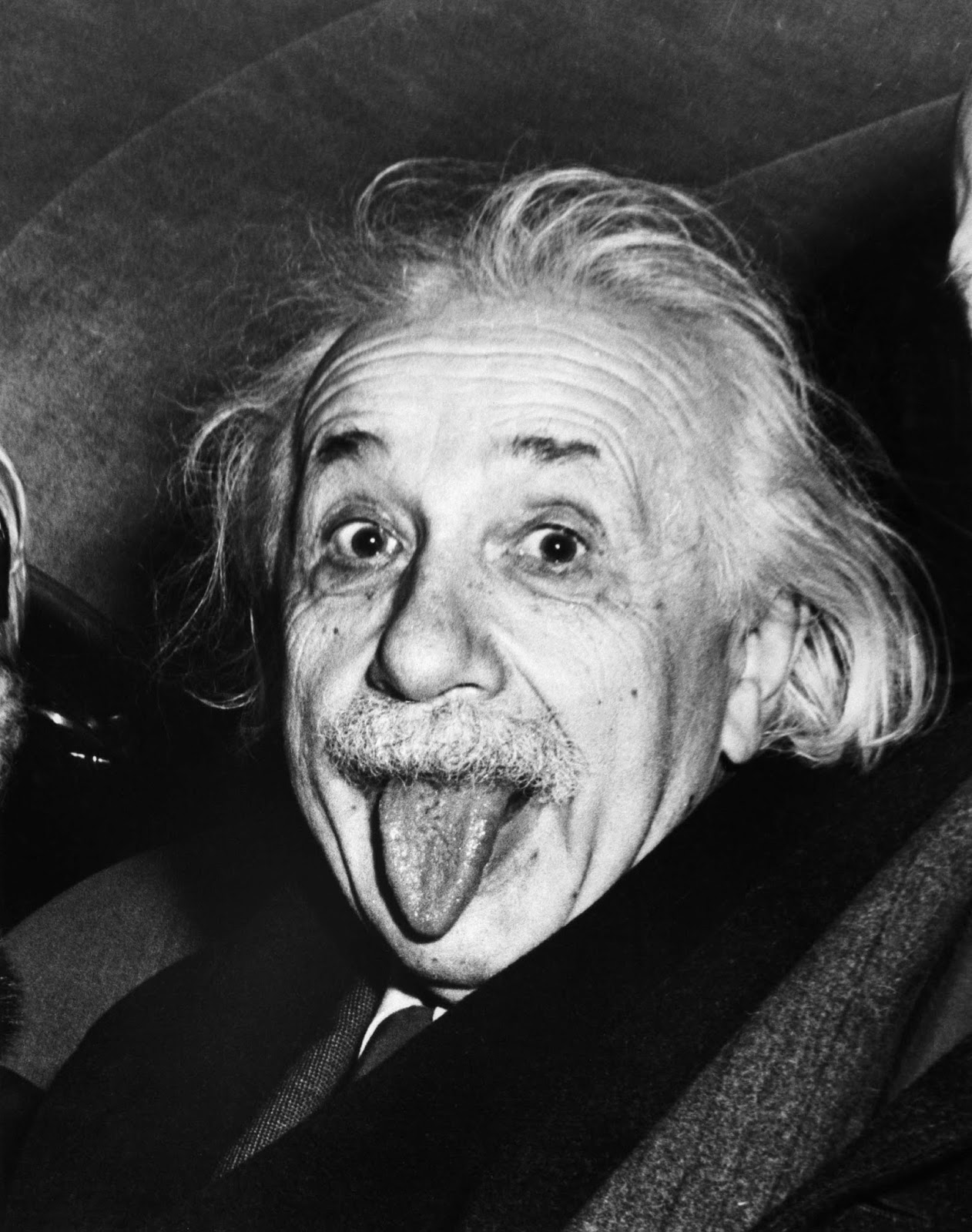






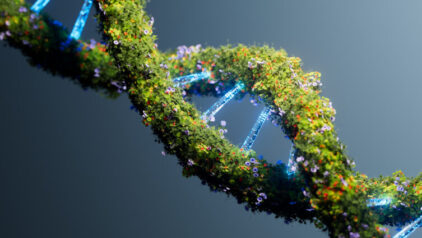

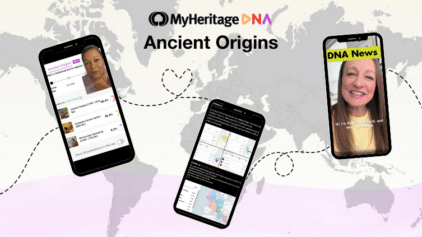
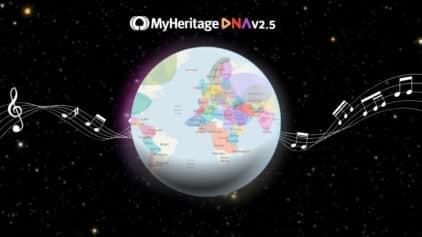
Jo Swearingen
February 28, 2019
I’m blown away with this new functionality. Its superiority to the competitor’s tool was evident the first day I compared them. Exciting stuff!